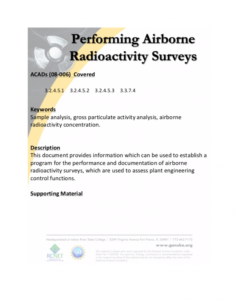RCNET ACAD 08-006 Crosswalk: 3.3.11 Radiological Protection Technicians - Conduct and Monitoring of Radiological Work

Program Description:
This material was published by the Regional Center for Nuclear Education and Training (RCNET) as part of a comprehensive crosswalk that links objectives of ACAD 08-006 with GP Strategies ABC Material, NUCP Surveyed Material, NANTeL resources, EPRI resources, web resources, and published material available to all RCNET partners. These accredited utility training programs are based off training and qualification guidelines (ACADs) published by the National Academy for Nuclear Training.
ACAD 08-006 is the Uniform Curriculum Guide for Nuclear Power Plant Technician, Maintenance, and Nonlicensed Operations Personnel Associate Degree Programs and includes five main curriculum areas: Core Curriculum, Discipline-Specific Curriculum for Nonlicensed Operators, Discipline-Specific Curriculum for Radiological Protection Technicians, Discipline-Specific for Chemistry Technicians, and Discipline Specific for Maintenance Personnel.
Contents:
This Conduct and Monitoring of Radiological Work section of Discipline-Specific Curriculum for Radiological Protection Technicians (ACAD 08-006 3.3.11) covers performing and/or monitoring radiological work operations.
Documents associated with ACAD 08-006 3.3.11 include three documents of curriculum information and lesson plans, and nine PowerPoint presentations.
This material covers, more specifically: performing and/or monitoring work in radiation areas, high radiation areas, and very high radiation areas; work in areas where the potential exists for rapidly changing dose rates, such as the spent fuel pool, during incore detector evolutions, and during radiography; work in contaminated areas; the opening of contaminated systems; work in areas with airborne radioactivity or the potential for airborne radioactivity; and work in areas with high does gradients. The material also covers the methods that can be used to invoke radiological protection requirements; the responsibilities of radiological protection technicians and supervisors in regards to complying with, monitoring, and enforcing radiological protection and ALARA requirements; and much more.
For orientation purposes Airborne_Radioactivity_Surveys.pdf is included as a separate attachment and offers a sample of the type of material included in this curriculum.
Below is a list of the files contained within the .zip attachment. The size of each file is included in parenthesis.
3.3.11 Conduct and Monitoring of Radiological Work (15 files, 107.8 MB)
- Documents
- Performing Airborne Radioactivity Surveys (Airborne_Radioactivity_Surveys.docx 445 KB)
- Chemical and Oily Waste Water Systems (Chemical_and_Oily_Waste_Water.rtf 134 KB)
- Primary Systems Chapter 16 (Primary_Systems.doc 16.9 MB)
- Presentations
- ALARA for Engineers (ALARAforEngineers.ppt 28.2 MB)
- Contamination Control, Decontamination and Respiratory Protection (Contamination_Control,_Decontamination_Respiratory_Protection.pptx 1.7 MB)
- Gaseous Radewaste and Explosive Gas Monitor (GaseousRadwaste.ppt 40 MB)
- Protection Against Radiation (Protection_Against_Radiation.ppt 8.2 MB)
- Radiation Detection Principles and Instruments (Radiation_Detection_Principles_and_Instruments.ppt 6.7 MB)
- Radioactive Material Handling (RadioactiveMaterialHandlingandInterpersonalSkills.ppt 2.8 MB)
- Radiological Safety Response (Radiological_Safety_&_Response.pptx 622 KB)
- Radiological Controls (RadiologicalControls.pptx 1.5 MB)
- Radiation Protection Technician Initial Training: Engineering Controls (RPTechnicianTrainingEngineeringControls.ppt 560 KB)
About this Resource


Comments